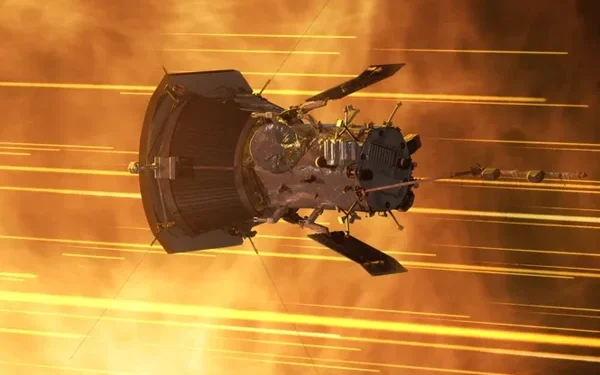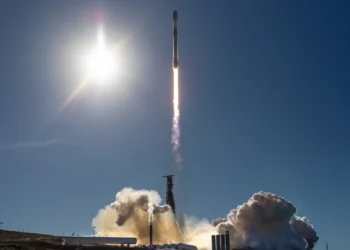Washington, D.C.: The National Aeronautics and Space Administration (NASA) has released the closest-ever image of the Sun, captured from a breathtaking distance of just 3.8 million miles. This historic image was taken by the Parker Solar Probe, a revolutionary spacecraft launched in 2018 with the mission of getting humanity closer to our star than ever before.
The unprecedented solar image, captured during the probe’s close pass on December 24, 2024, is a landmark achievement in space exploration and solar physics. It provides an awe-inspiring view of the Sun’s outer atmosphere—the corona—and reveals fascinating details about solar activity that were previously impossible to observe.
A Mission to Touch the Sun: The Parker Solar Probe Journey
The Parker Solar Probe, named after astrophysicist Dr. Eugene Parker, who pioneered the concept of the solar wind, was launched on August 12, 2018 from Cape Canaveral Air Force Station in Florida. This mission is part of NASA’s Living With a Star program and aims to unravel the mysteries of the Sun’s atmosphere, magnetic fields, and particle emissions.
To achieve its goal of “touching the Sun,” the probe follows a unique, elliptical orbit that takes it closer to the Sun with each pass, using gravity assists from Venus to tighten its trajectory. On December 24, 2024, it reached one of its closest approaches—called perihelion—at just 3.8 million miles (6.1 million kilometers) from the Sun’s surface.
What the New Image Reveals
The image released by NASA offers a never-before-seen close-up of the Sun, capturing plasma loops, solar flares, and fine-scale structures of the corona with remarkable clarity. These features are essential to understanding how energy and heat move through the solar atmosphere and into space.
Key highlights of the image and accompanying data include:
- Coronal streamers and magnetic loops shooting thousands of miles into space
- Fine details in the solar wind—charged particles that flow from the Sun and influence the entire solar system
- Unexpected turbulence and magnetic switchbacks, where the solar magnetic field reverses direction suddenly
These discoveries are vital to improving our understanding of solar dynamics and their impact on Earth and space systems.
Scientific Significance: Understanding Space Weather
One of the key goals of the Parker Solar Probe mission is to study the phenomena behind space weather—disturbances caused by solar wind and coronal mass ejections (CMEs) that can interfere with satellite operations, GPS systems, power grids, and even pose a threat to astronauts in space.
NASA’s Space Weather Objectives
According to Nicky Fox, the Associate Administrator for NASA’s Science Mission Directorate, the new data acquired during the probe’s flyby will help scientists:
“…improve space weather forecasts to ensure the safety of astronauts and technology on Earth and throughout the solar system.”
By understanding the sources and mechanisms of solar eruptions, scientists can build more accurate models to predict events that may affect Earth’s space environment.
The Sun: A Dynamic Star Still Full of Mysteries
Though the Sun is the most studied star in our universe, many fundamental questions about its behavior remain unanswered. Among them:
- Why is the solar corona—the outermost layer of the Sun’s atmosphere—millions of degrees hotter than its surface?
- How is the solar wind accelerated to supersonic speeds?
- What causes the formation of solar flares and CMEs?
The Parker Solar Probe is designed to address these mysteries by diving into the corona and sampling the environment directly.
Technology Behind the Parker Solar Probe
To survive its journey into one of the harshest environments in the solar system, the Parker Solar Probe is equipped with cutting-edge engineering features, including:
Thermal Protection System (TPS)
A revolutionary carbon-composite heat shield, 4.5 inches thick, protects the probe from temperatures exceeding 2,500°F (1,377°C).
Autonomous Navigation
Due to communication delays with Earth, the spacecraft uses real-time decision-making systems to protect itself from unexpected solar activity.
Scientific Instruments
The probe is fitted with four main scientific instruments:
- FIELDS: Measures electric and magnetic fields
- WISPR: Captures images of the solar corona and solar wind (used to take the newly released image)
- SWEAP: Collects data on solar particles
- ISʘIS: Observes energetic particles from solar flares and shock waves
Mission Progress and Future Milestones
The Parker Solar Probe has already completed multiple solar orbits and gravity assists using Venus flybys. With each pass, it inches closer to its final target of 3.83 million miles (6.16 million kilometers)—about 1/10th the distance between the Sun and Mercury.
The December 24, 2024 encounter was the 14th perihelion, and the image captured during this phase is now the closest visual record of the Sun in human history. NASA has confirmed that the probe will make even closer approaches in 2025 and 2026, with more data expected in future phases.
Global Collaboration and Data Sharing
Although led by NASA, the Parker Solar Probe mission is a collaborative effort involving global scientists, engineers, and institutions. Universities, research labs, and observatories across Europe, the U.S., and Asia are contributing to data analysis, modeling, and outreach.
NASA has committed to publicly releasing scientific data from the probe, ensuring that researchers worldwide can participate in solar physics advancements.
Why This Mission Matters for Earth
Solar activity affects more than just the space around the Sun. It plays a direct role in shaping Earth’s magnetic field, aurora activity, and communications systems. During periods of high solar activity, the risk of space-based disruptions increases.
Understanding the drivers of space weather is crucial not only for scientific discovery but also for technological resilience. Modern societies depend heavily on space infrastructure—satellites for navigation, telecommunications, defense, and climate monitoring—and all of these systems are vulnerable to solar storms.
Public Enthusiasm and Scientific Legacy
The release of the closest image of the Sun has generated widespread excitement among space enthusiasts, educators, and scientists. Educational institutions are leveraging the data for STEM outreach, and the public is gaining a newfound appreciation for solar science.
The Parker Solar Probe mission is often compared to the Apollo missions in terms of its groundbreaking scope. Where Apollo helped us understand the Moon, Parker is revealing the dynamics of our solar system’s heart—the Sun.
Conclusion: A Glimpse Into the Heart of Our Solar System
With the release of the closest image of the Sun ever captured, NASA’s Parker Solar Probe has once again demonstrated the incredible potential of human ingenuity and space science. The data from its close encounter on December 24, 2024, will help scientists around the world decode the mysteries of solar activity, advance space weather forecasting, and protect astronauts and satellites in space.
As the probe continues its daring journey into the solar corona, each new pass brings us closer to answering age-old questions about the nature of our star and the forces that shape our cosmic neighborhood.

























